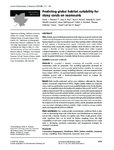Predicting global habitat suitability for stony corals on seamounts
| dc.contributor.author | Tittensor, DP | |
| dc.contributor.author | Baco, AR | |
| dc.contributor.author | Brewin, PE | |
| dc.contributor.author | Clark, MR | |
| dc.contributor.author | Consalvey, M | |
| dc.contributor.author | Hall‐Spencer, J | |
| dc.contributor.author | Rowden, AA | |
| dc.contributor.author | Schlacher, T | |
| dc.contributor.author | Stocks, KI | |
| dc.contributor.author | Rogers, AD | |
| dc.date.accessioned | 2013-02-22T20:40:33Z | |
| dc.date.available | 2013-02-22T20:40:33Z | |
| dc.date.issued | 2009-06 | |
| dc.identifier.issn | 0305-0270 | |
| dc.identifier.issn | 1365-2699 | |
| dc.identifier.uri | http://hdl.handle.net/10026.1/1415 | |
| dc.description.abstract |
<jats:title>Abstract</jats:title><jats:p><jats:bold>Aim </jats:bold> Globally, species distribution patterns in the deep sea are poorly resolved, with spatial coverage being sparse for most taxa and true absence data missing. Increasing human impacts on deep‐sea ecosystems mean that reaching a better understanding of such patterns is becoming more urgent. Cold‐water stony corals (Order Scleractinia) form structurally complex habitats (dense thickets or reefs) that can support a diversity of other associated fauna. Despite their widely accepted ecological importance, records of scleractinian corals on seamounts are patchy and simply not available for most of the global ocean. The objective of this paper is to model the global distribution of suitable habitat for stony corals on seamounts.</jats:p><jats:p><jats:bold>Location </jats:bold> Seamounts worldwide.</jats:p><jats:p><jats:bold>Methods </jats:bold> We compiled a database containing all accessible records of scleractinian corals on seamounts. Two modelling approaches developed for presence‐only data were used to predict global habitat suitability for seamount scleractinians: maximum entropy modelling (Maxent) and environmental niche factor analysis (ENFA). We generated habitat‐suitability maps and used a cross‐validation process with a threshold‐independent metric to evaluate the performance of the models.</jats:p><jats:p><jats:bold>Results </jats:bold> Both models performed well in cross‐validation, although the Maxent method consistently outperformed ENFA. Highly suitable habitat for seamount stony corals was predicted to occur at most modelled depths in the North Atlantic, and in a circumglobal strip in the Southern Hemisphere between 20° and 50° S and shallower than around 1500 m. Seamount summits in most other regions appeared much less likely to provide suitable habitat, except for small near‐surface patches. The patterns of habitat suitability largely reflect current biogeographical knowledge. Environmental variables positively associated with high predicted habitat suitability included the aragonite saturation state, and oxygen saturation and concentration. By contrast, low levels of dissolved inorganic carbon, nitrate, phosphate and silicate were associated with high predicted suitability. High correlation among variables made assessing individual drivers difficult.</jats:p><jats:p><jats:bold>Main conclusions </jats:bold> Our models predict environmental conditions likely to play a role in determining large‐scale scleractinian coral distributions on seamounts, and provide a baseline scenario on a global scale. These results present a first‐order hypothesis that can be tested by further sampling. Given the high vulnerability of cold‐water corals to human impacts, such predictions are crucial tools in developing worldwide conservation and management strategies for seamount ecosystems.</jats:p> | |
| dc.format.extent | 1111-1128 | |
| dc.format.medium | Undetermined | |
| dc.language | en | |
| dc.language.iso | en | |
| dc.publisher | Wiley | |
| dc.subject | Conservation biogeography | |
| dc.subject | distribution | |
| dc.subject | ENFA | |
| dc.subject | habitat suitability | |
| dc.subject | maximum entropy | |
| dc.subject | modelling | |
| dc.subject | niche | |
| dc.subject | Scleractinia | |
| dc.subject | seamount | |
| dc.subject | stony coral | |
| dc.title | Predicting global habitat suitability for stony corals on seamounts | |
| dc.type | journal-article | |
| dc.type | Journal Article | |
| plymouth.author-url | https://www.webofscience.com/api/gateway?GWVersion=2&SrcApp=PARTNER_APP&SrcAuth=LinksAMR&KeyUT=WOS:000266242800011&DestLinkType=FullRecord&DestApp=ALL_WOS&UsrCustomerID=11bb513d99f797142bcfeffcc58ea008 | |
| plymouth.issue | 6 | |
| plymouth.volume | 36 | |
| plymouth.publication-status | Published | |
| plymouth.journal | Journal of Biogeography | |
| dc.identifier.doi | 10.1111/j.1365-2699.2008.02062.x | |
| plymouth.organisational-group | /Plymouth | |
| plymouth.organisational-group | /Plymouth/Faculty of Science and Engineering | |
| plymouth.organisational-group | /Plymouth/Faculty of Science and Engineering/School of Biological and Marine Sciences | |
| plymouth.organisational-group | /Plymouth/PRIMaRE Publications | |
| plymouth.organisational-group | /Plymouth/REF 2021 Researchers by UoA | |
| plymouth.organisational-group | /Plymouth/REF 2021 Researchers by UoA/UoA07 Earth Systems and Environmental Sciences | |
| plymouth.organisational-group | /Plymouth/Research Groups | |
| plymouth.organisational-group | /Plymouth/Research Groups/Marine Institute | |
| plymouth.organisational-group | /Plymouth/Users by role | |
| plymouth.organisational-group | /Plymouth/Users by role/Academics | |
| dc.identifier.eissn | 1365-2699 | |
| dc.rights.embargoperiod | Not known | |
| rioxxterms.versionofrecord | 10.1111/j.1365-2699.2008.02062.x | |
| rioxxterms.licenseref.uri | http://www.rioxx.net/licenses/all-rights-reserved | |
| rioxxterms.type | Journal Article/Review |


